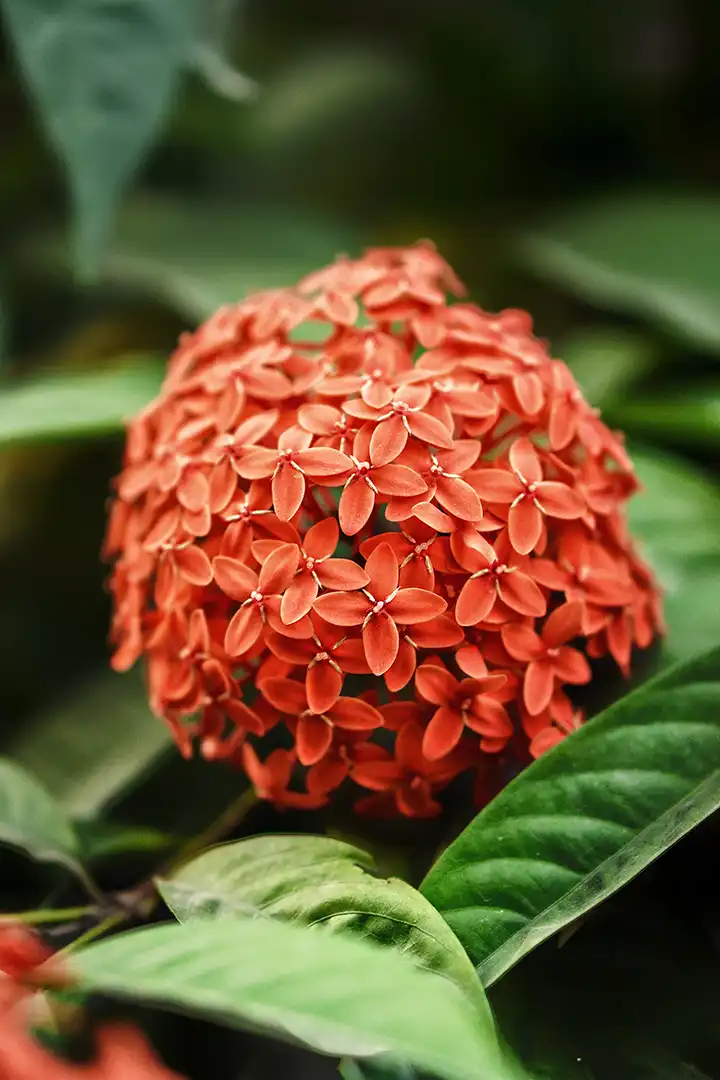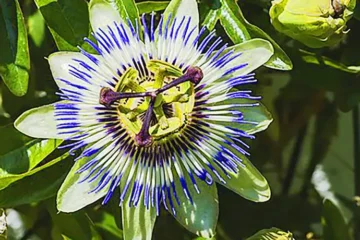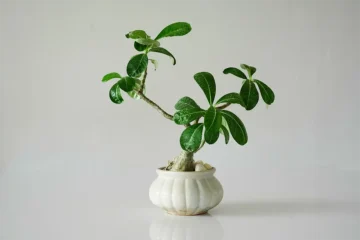| Plant Name | Ixora Plant |
| Family | Rubiaceae |
| Sub Family | Ixoroideae |
| Species | Ixora coccinea, Ixora chinensis, Ixora finlaysoniana, and Ixora undulata |
| Soil Requirement | Well Draining Soil, Slight Acidic Soil |
| Sunlight Requirement | At least 4 to 6 hours of Sunlight |
| Temperature Requirement | 60 to 90 °F (15 to 40 ° celsius) |
| Flowering Period | March to September |
| Height | 3 to 6 feet (0.9 to 1.8 meter) but it can grow up to 9 feet. |
| Propagation | Easy by stem cutting |
| Fertilizer Requirement | Every 4 to 6 weeks |
| Pest | Mealybugs, Aphids, Spider mites, Whiteflies |
| Medicinal Properties | Yes |
| Toxicity | Generally Non Toxic |
Looking for tips about care for an ixora plant? This post provides general information and tips on how to care for your ixora plant, including watering, sunlight, pruning, and fertilizing. Whether you’re a seasoned gardener or a beginner, this guide will help you keep your ixora healthy and thriving.
Table of Contents
Introduction
The Ixora plant is a tropical shrub known for its vibrant, showy blooms and lush, glossy foliage. Native to Southeast Asia, the ixora plant has been cultivated for centuries for its ornamental and medicinal properties. With its bright clusters of red, orange, pink, and yellow flowers, the ixora plant is a popular choice for gardeners and landscapers looking to add a splash of color and exotic flair to their outdoor spaces.
In addition to its striking appearance, the ixora plant has been used for centuries in traditional medicine to treat a range of ailments. Its leaves, flowers, and roots contain compounds that have been shown to have antibacterial, anti-inflammatory, and antioxidant properties. Whether you’re interested in cultivating the ixora plant for its beauty or its medicinal benefits, there’s no denying that this tropical shrub is a fascinating and versatile addition to any garden or home.
The scientific name for the ixora plant is Ixora coccinea. It belongs to the family Rubiaceae, which includes more than 13,000 species of flowering plants. The Rubiaceae family is one of the largest families of flowering plants and is found in tropical and subtropical regions around the world.
Ixora coccinea is a species of flowering plant that is native to tropical Southeast Asia, including India and Sri Lanka. It is also commonly known as the flame of the woods, jungle geranium, and needle flower. There are more than 400 different species of ixora plants, but Ixora coccinea is the most commonly grown species.
Other species in the ixora genus include Ixora chinensis, Ixora finlaysoniana, and Ixora undulata. These species are also native to Southeast Asia and are commonly grown as ornamental plants for their attractive flowers and foliage.
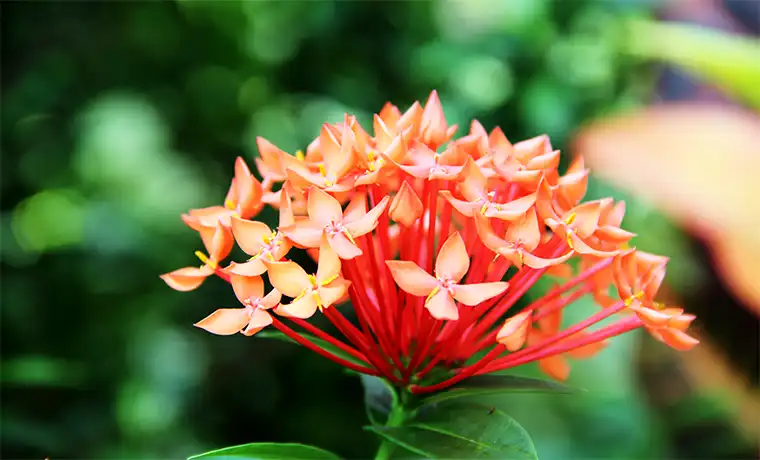
Ixora plants are closely related to other plants in the Rubiaceae family, such as coffee, gardenia, and pentas. Many of these plants share similar characteristics, which are opposite leaves and clusters of small, tubular flowers. They are mostly grown for their ornamental value, as well as their medicinal properties.
Soil requirement for ixora plant
The Ixora plant has specific soil requirements for good growth and health. Here are some key points to keep in mind when considering the soil for your ixora plant:
Well-draining soil: The ixora plant prefers soil that drains well, as waterlogged soil can lead to root rot and other problems. Make sure the soil is loose and well-draining, with good aeration. You can also make a small hole in the bottom of your pot so that the extra water will come out.
Slightly acidic soil: Ixora plants like soil with a slightly acidic pH level between 5.0 and 6.5. You can adjust the pH level of the soil by adding amendments such as sulfur or peat moss.
Nutrient-rich soil: The ixora plant thrives in soil that is rich in organic matter and nutrients. Before planting, amend the soil with compost or other organic matter to provide a good source of nutrients.
Moist soil: Although ixora plants prefer well-draining soil, they also need consistent moisture to thrive. Water the plant regularly, keeping the soil evenly moist but not waterlogged.
How often to water ixora plant
Ixora plants require consistent moisture to thrive, but overwatering can lead to problems such as root rot. Here are some general guidelines on how often to water an ixora plant:
Water the ixora plant deeply once or twice a week during the growing season (spring and summer), depending on the soil moisture levels and weather conditions.
In the winter season, water the ixora plant less frequently, allowing the soil to dry out slightly between waterings.
Avoid overwatering, as ixora plants are susceptible to root rot. Make sure the soil is well-draining and never allow the plant to sit in standing water.
If the leaves start to turn yellow or drop, it may be a sign of overwatering or underwatering. Adjust the watering schedule accordingly.
It’s important to note that the watering frequency may vary based on the environmental conditions and specific needs of your ixora plant.
Monitor the soil moisture levels regularly, and adjust the watering schedule as needed to keep the soil consistently moist without being waterlogged. With proper watering and care, your ixora plant should thrive and produce beautiful blooms.
Learn How to Grow and Care for Passiflora caerulea, read our post by clicking here.
Sunlight requirement of an Ixora Plant and the Weather it can withstand:
Ixora plants require bright, direct sunlight to produce their vibrant blooms, but they can also tolerate some shade. Here are some key points to keep in mind regarding sunlight requirements and weather tolerance for Ixora plants:
Sunlight
Ixora plants prefer full sun to partial shade, with at least four to six hours of direct sunlight each day. The more sunlight the plant receives, the more abundant and vibrant its blooms will be.
Temperature
Ixora plants are tropical plants that prefer warm temperatures between 60 and 90 degrees Fahrenheit. They can be sensitive to frost and cold temperatures, so it’s important to protect them from frost damage in cooler climates.
Humidity
Ixora plants prefer high humidity levels, so it’s important to keep the air around them moist. You can increase humidity levels by misting the leaves with water or placing a humidifier nearby.
Wind
Ixora plants can be sensitive to strong winds, which can damage their delicate blooms and foliage. If your area is prone to strong winds, consider planting the ixora plant in a sheltered location or using windbreaks to protect it.
Propagation of Ixora Plant
Ixora plants can be propagated by stem cuttings, air layering, or seeds. Here’s an overview of each propagation method:
Stem cuttings
Propagating ixora plants from stem cuttings is a simple and effective method. To do this, take a 4-6 inch cutting from a healthy ixora plant, making sure it has at least two or three leaf nodes. Remove the leaves from the bottom of the cutting, dip the cut end in the rooting hormone, and plant it in a well-draining potting mix. Water the cutting thoroughly and place it in a warm, bright location with high humidity. Keep the soil moist and within a few weeks, the cutting should begin to develop roots.
Air layering
Air layering is a more advanced propagation method that involves creating a small wound on a healthy stem and encouraging it to produce roots. To do this, make a small cut in the stem and wrap it in damp sphagnum moss. Cover the moss with plastic wrap and secure it in place with string or rubber bands. Keep the moss moist and within a few weeks, roots should begin to grow from the wound. Once the roots have developed, cut the stem below the new root system and plant the cutting in a pot.
Seeds
Propagating ixora plants from seeds can be more challenging, as the seeds have a low germination rate and may take several months to sprout. To do this, collect the seeds from a mature ixora plant and plant them in a well-draining potting mix. Keep the soil moist and in a warm, bright location. The seeds may take several weeks or months to sprout, and it can take several years for the plants to mature.
In summary, ixora plants can be propagated by stem cuttings, air layering, or seeds. Stem cuttings are the easiest and most reliable method, while air layering and seeds require more patience and skill. Whatever method you choose, make sure to provide the proper environmental conditions to ensure successful propagation.
Flowers of ixora plant
The flowers of the ixora plant are some of its most distinctive features. The plant produces large clusters of small, tubular flowers that are arranged in spherical inflorescences at the end of each branch. The flowers can range in color from white, pink, orange, yellow, and red, depending on the species and cultivar.
The Ixora plant is a prolific bloomer, and it typically produces flowers in the spring and summer months, although some species may bloom throughout the year. The flowers are highly attractive to pollinators such as bees, butterflies, and hummingbirds, making the plant a valuable addition to any garden or landscape.
Fruits of ixora plant
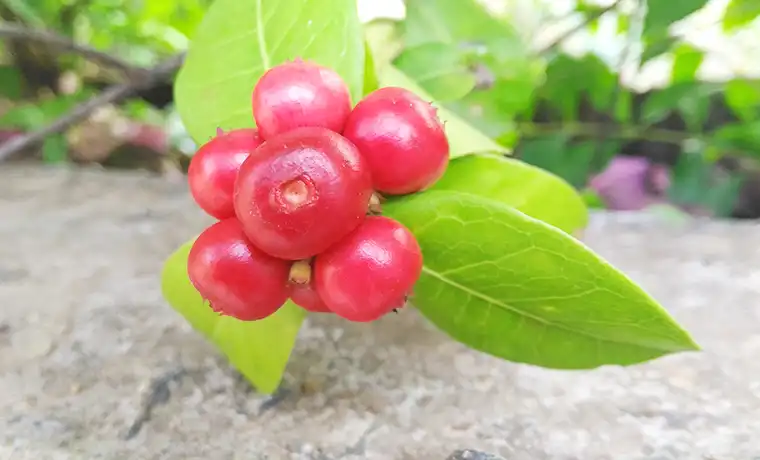
After the flowers have been pollinated, the ixora plant produces small, round, and fleshy fruits that contain one or two seeds. The fruits are initially green and turn reddish-purple as they mature, giving the plant an additional ornamental value. However, the fruits are generally not edible and may even be toxic to some animals if ingested.
Ixora Plant fertilizer requirement
Ixora plants benefit from regular fertilization to maintain healthy growth and vibrant blooms. Here are some tips on fertilizing ixora plants:
Frequency
Ixora plants should be fertilized every 4 to 6 weeks during the growing season, which typically runs from spring through fall.
Type of fertilizer
A balanced, slow-release fertilizer with equal parts of nitrogen, phosphorus, and potassium (NPK) is ideal for Ixora plants. Look for a fertilizer with an NPK ratio of 10-10-10 or 12-12-12.
Application
Apply the fertilizer evenly around the base of the plant, taking care not to get any on the leaves or flowers. Water the plant thoroughly after fertilizing to ensure that the nutrients are absorbed into the soil.
Organic fertilizers
Alternatively, you can also use organic fertilizers such as compost, bone meal, or manure. These fertilizers provide a slow release of nutrients and help to improve soil quality.
Special considerations
It is also worth remembering that Ixora plants may also benefit from fertilizers that are specifically formulated for acid-loving plants, as they prefer a slightly acidic soil pH.
It is important not to over-fertilize ixora plants, as this can lead to nutrient burn or other problems. Always follow the instructions on the fertilizer package and adjust the amount and frequency of fertilization based on the needs of your specific plant.
Ixora Plant pest and pesticide
Ixora plants are generally resistant to pests and diseases, but they can still be affected by a few common pests. Here are some of the most common pests that can affect ixora plants and how to control them:
Aphids
Aphids are small, soft-bodied insects that can cluster on the leaves and stems of ixora plants. They suck the sap from the plant, causing leaves to curl and turn yellow. To control aphids, spray the plant with a strong stream of water or use an insecticidal soap or oil.
Spider mites
Spider mites are tiny pests that feed on the undersides of the leaves, causing yellowing and stippling. They can be controlled with a spray of water or by using a miticide.
Whiteflies
Whiteflies are small, winged insects that can infest the leaves of ixora plants, causing them to turn yellow and die. To control whiteflies, spray the plant with water or use an insecticidal soap or oil.
It’s important to use caution when using pesticides on ixora plants, as they can be sensitive to chemicals. Before using any pesticide, read the label carefully and follow the instructions closely. It’s often best to start with non-toxic or organic pest control methods, such as using beneficial insects or spraying the plant with water, before resorting to chemical pesticides. If you do use a chemical pesticide, be sure to follow all safety precautions and avoid spraying the plant during hot, sunny weather or when the plant is stressed.
Ixora plant medicinal use
Ixora plants have a long history of use in traditional medicine in various cultures. The plant has been used to treat a wide range of ailments, including skin disorders, fever, inflammation, and digestive problems. Here are some examples of the medicinal uses of Ixora:
Skin disorders
In many cultures, ixora leaves and flowers are used topically to treat various skin disorders, such as eczema, dermatitis, and psoriasis. The plant’s anti-inflammatory and antibacterial properties are believed to help soothe and heal irritated skin.
Fever
The leaves of the ixora plant are also used to reduce fever. The plant’s cooling properties are believed to help lower body temperature and reduce inflammation.
Digestive problems
Ixora is also used to treat digestive problems such as diarrhea, dysentery, and stomach cramps. The plant’s astringent properties are believed to help reduce inflammation and soothe the digestive tract.
Antimicrobial properties
Ixora extracts have been found to have antimicrobial properties, which make them useful in treating bacterial and fungal infections.
Ixora plants have a long history of use in traditional medicine however, it is important to note that many of these uses have not been scientifically validated. If you are considering using Ixora for medicinal purposes, it is important to consult with a healthcare provider or herbalist to ensure that it is safe and effective for your specific needs.
Is ixora plant toxic?
The ixora plant is not generally considered toxic to humans, although some species may cause skin irritation or allergic reactions in sensitive individuals. The plant is also not toxic to dogs, cats, or other pets, although ingestion of large quantities of leaves or flowers may cause mild gastrointestinal upset or vomiting.
However, it is important to note that some species of ixora, such as Ixora coccinea, contain small amounts of a compound called ursolic acid, which has been shown to have antitumor and anti-inflammatory properties. While the compound is generally considered safe in small quantities, ingestion of large amounts may cause adverse effects.
As with any plant, it is recommended to handle ixora with care and to keep it out of reach of children and pets. If you have any concerns about the safety of ixora, it is always best to consult with a healthcare provider or veterinarian.
Does ixora plant give oxygen?
Like all plants, Ixora plants produce oxygen as a byproduct of photosynthesis. During the daytime, when light is available, the ixora plant absorbs carbon dioxide from the air and uses it, along with water and sunlight, to produce energy in the form of glucose. As a byproduct of this process, the plant releases oxygen into the air.
despite the amount of oxygen produced by an individual ixora plant being relatively small, when grown in large numbers, Ixora plants can contribute to the overall oxygen supply in the surrounding environment. Also, Ixora plants, like many other houseplants, can help to purify the air by removing harmful pollutants such as formaldehyde, benzene, and trichloroethylene.
Does Ixora plant produce Coffee?
Ixora plants do not produce coffee. The coffee plant (Coffea species) is a different plant entirely and is a member of the Rubiaceae family, like Ixora plants. However, while both coffee plants and Ixora plants belong to the same family, they are different species and have distinct characteristics and uses. The coffee plant is cultivated for its coffee beans, which are roasted and ground to produce the popular beverage. On the other hand, Ixora plants are grown for their showy clusters of colorful flowers and are used primarily for ornamental purposes.
